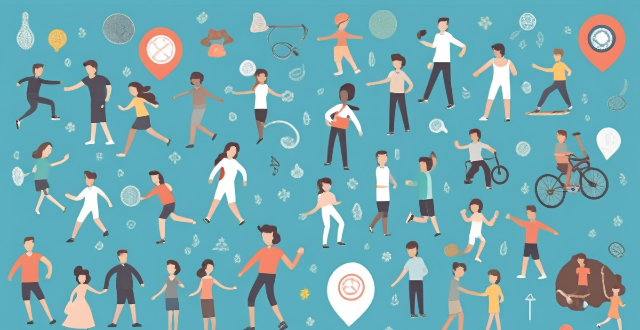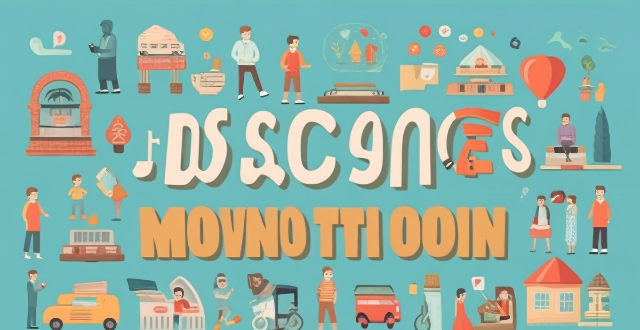Social Role

What role does social media play in shaping a celebrity's image and brand ?
The text discusses the role of social media in shaping a celebrity's image and brand. It outlines six key ways in which social media impacts a celebrity's public perception and personal branding: connecting with fans, controlling the narrative, promoting projects, endorsements and sponsorships, crisis management, and personal branding. The text emphasizes that social media is an integral part of modern society and plays a significant role in building a loyal fan base, generating buzz for projects, expanding reach and influence through endorsements, handling crises effectively, and developing a distinct personal brand.

What role does social media play in modern journalism ?
The Role of Social Media in Modern Journalism Social media has become an integral part of modern journalism, playing a significant role in the way news is gathered, distributed, and consumed. Here are some key ways social media influences journalism: 1. Breaking News and Real-Time Updates 2. Audience Interaction and Feedback 3. Investigative Journalism 4. Verification and Fact-Checking 5. Distribution and Content Promotion 6. Brand Building for Journalists 7. Monetization Opportunities 8. Ethical Considerations Overall, social media has reshaped journalism by providing new avenues for storytelling, audience engagement, and distribution. However, it also poses challenges related to accuracy, ethics, and the commercial aspects of news dissemination. Journalists must navigate these complexities to leverage social media effectively while maintaining the integrity of their craft.

What role does social media play in digital marketing ?
The Role of Social Media in Digital Marketing Social media has become an essential component of digital marketing, offering businesses numerous opportunities to promote their products and services online. Here are some key ways social media influences digital marketing: 1. Brand Awareness and Visibility - Increased Exposure: Social media platforms offer businesses a chance to reach a wider audience, increasing brand visibility. - Targeted Ads: Platforms like Facebook and Instagram allow for targeted advertising, ensuring that the right message reaches the right people. - Hashtags and Trending Topics: By participating in trending topics and using relevant hashtags, brands can increase their visibility and join conversations that align with their values. 2. Customer Engagement and Interaction - Direct Communication: Social media provides a platform for direct communication between businesses and customers, fostering better relationships. - Instant Feedback: Businesses can receive immediate feedback from customers, helping them improve products or services quickly. - Loyalty and Advocacy: Engaged customers often become brand advocates, promoting the business through word-of-mouth on their own social networks. 3. Content Marketing - Rich Media: Social media allows for various forms of content, including images, videos, and articles, making it easier to engage users. - Storytelling: Brands can use social media to tell stories that resonate with their audience, creating an emotional connection. - Influencer Collaborations: Partnering with influencers can help extend a brand's reach and credibility among specific demographics. 4. Lead Generation and Conversion - Promotions and Discounts: Social media is an effective channel for promoting sales and discounts, driving traffic to websites or physical stores. - Contests and Giveaways: These activities not only generate excitement but also encourage user-generated content, further expanding a brand's reach. - Retargeting: Through retargeting ads, businesses can remind potential customers of their interest in a product or service after they've interacted with the brand online. 5. Data Collection and Analysis - Insights and Analytics: Most social media platforms provide analytics tools that offer valuable insights into customer behavior and preferences. - Audience Segmentation: By analyzing social media data, businesses can segment their audience and tailor their marketing efforts accordingly. - Competitive Analysis: Social media also allows businesses to monitor competitors' activities and strategies, helping them stay ahead in the market. In conclusion, social media plays a multifaceted role in digital marketing, from enhancing brand visibility to facilitating customer interactions and generating leads. As technology continues to evolve, so will the ways in which social media influences digital marketing strategies.

What role does social media play in product review dissemination ?
The article discusses the significant role of social media in product review dissemination. It highlights the concept of "social proof" where people trust and adopt a product seeing others using it and sharing positive reviews. Social media platforms provide a platform for users to share their experiences with products, both good and bad, which can greatly influence potential customers' purchasing decisions. User-generated content (UGC) is a powerful tool for brands looking to promote their products. By encouraging customers to share their experiences with a product on social media, brands can leverage the power of social proof to attract new customers. Influencer marketing is another way that social media affects product review dissemination. Brands partner with influencers who have large followings on social media platforms to promote their products. Online reviews have become an essential part of the purchasing process for many consumers. Social media platforms provide a space for users to share their thoughts and opinions about products, allowing potential customers to make informed decisions before making a purchase. The trustworthiness, variety of opinions, and timeliness of online reviews greatly impact a consumer's decision to purchase a product or not. In conclusion, social media plays a crucial role in product review dissemination by providing a platform for users to share their experiences with products, promoting user-generated content and influencer marketing, and facilitating the sharing of online reviews.

What is the role of social media in sports marketing ?
The article explores the role of social media in sports marketing, highlighting its ability to engage with fans, promote events, and build brand awareness. It suggests that by producing high-quality content and engaging with followers, sports organizations can increase their online presence and attract new fans. The article also discusses strategies for promoting events on social media, such as targeted advertising and word-of-mouth marketing. Overall, it emphasizes the importance of social media in modern sports marketing and encourages teams to leverage these platforms to reach their target audience.

What role does social media play in the communication of climate science ?
The text discusses the role of social media in climate science communication. It highlights three main ways in which social media influences this field: awareness and education, engaging with the public, and promoting action and advocacy. The author provides examples for each category, such as sharing infographics and videos on platforms like Facebook or Twitter to educate people about climate change, conducting polls and surveys to gather feedback from the public, and initiating challenges or campaigns to encourage sustainable practices. The text concludes by emphasizing the importance of leveraging social media to spread accurate information, foster dialogue, and inspire collective action towards mitigating the effects of climate change.

What role do sports stars and influencers have in promoting social inclusion and diversity ?
The role of sports stars and influencers in promoting social inclusion and diversity is significant. They break down barriers by enhancing visibility and representation of diverse groups, serve as positive role models, promote inclusive practices in sports, and drive social change through collaborations and partnerships. Their actions help create an accepting and inclusive society where everyone feels valued and respected regardless of their background or identity.

What role does social media play in the promotion of sports and fitness ?
Social media plays a significant role in promoting sports and fitness by connecting people with similar interests, providing access to information and resources, enhancing brand awareness and marketing efforts, facilitating fundraising and charitable events, and encouraging healthy lifestyle choices. It has become an essential tool for creating communities around various sports and fitness activities, allowing individuals to find like-minded individuals, form communities, and share their experiences, knowledge, and achievements. Social media also offers a vast amount of information and resources related to sports and fitness, making it possible for individuals to learn about new techniques, training methods, and health tips without leaving their homes. Additionally, social media platforms often feature live streams of sporting events, allowing fans to watch their favorite teams and athletes compete in real-time. In conclusion, social media is an effective tool for promoting sports and fitness, and its impact will continue to grow as technology evolves.

What role does social media play in organizing and promoting fan support events ?
Social media is a crucial tool for organizing and promoting fan support events, connecting fans, promoting events, engaging fans, and measuring success. It allows fans to form online communities dedicated to their favorite artists or sports teams, share news, updates, and information about upcoming events. Artists, sports teams, and event organizers can use social media to announce upcoming events, share details about the event, and encourage fans to attend. Social media also provides opportunities for fans to engage with their favorite artists or sports teams in meaningful ways, such as participating in contests and giveaways or sharing user-generated content related to the event. Finally, social media provides valuable data that can be used to measure the success of fan support events by tracking metrics such as likes, shares, comments, and reach.

How does social harmony impact economic development and stability ?
Social harmony is essential for economic development and stability, as it increases productivity, reduces conflict, improves governance, attracts foreign investment, and enhances social cohesion.

How does sports improve social skills ?
Sports significantly enhance social skills through teamwork, confidence-building, dealing with diversity, interpersonal development, and leadership. Participation fosters cooperation, communication, shared responsibility, achievement, resilience, public performance, acceptance, adaptability, respect, networking, empathy, conflict resolution, role assumption, motivation, and decision-making. These skills are transferable to various aspects of life, making sports a valuable platform for personal growth and social interaction.

How does social media influence consumer behavior ?
Social media has transformed consumer behavior by increasing brand awareness, influencing purchasing habits, and changing perceptions of brands. It enables consumers to compare products, share feedback, and engage with companies directly. Social media also plays a crucial role in product development by providing insights into consumer needs and preferences. Companies can foster customer loyalty through engagement and exclusive deals on these platforms. The rise of social commerce allows for direct purchases within apps and live streaming sales events. Personalization and targeted marketing, including influencer collaborations, further impact consumer choices. Overall, social media's influence on consumer behavior is significant and continues to evolve with technological advancements.

How has social media influenced environmental awareness campaigns ?
The text discusses how social media has revolutionized communication and information sharing, particularly in the context of environmental awareness campaigns. It outlines various ways in which social media has impacted these campaigns, including increased visibility, interactivity, accessibility, influence of celebrities and influencers, real-time updates, and crowdsourcing and fundraising opportunities. The text concludes that social media is an essential tool for promoting environmental causes and will likely continue to play a significant role in shaping our understanding of the environment and inspiring action.

How does team sports contribute to social well-being ?
Team sports significantly contribute to social well-being by building a sense of community, promoting cooperation and teamwork, providing opportunities for personal growth, enhancing health and well-being, integrating into society, and encouraging civic engagement and social responsibility. These activities not only bring people together but also teach valuable life skills that extend beyond the playing field, positively impacting individuals and society as a whole.

How does one's personal hygiene affect their social interactions ?
Personal hygiene is crucial for positive social interactions, boosting confidence, and maintaining good health. Good hygiene habits include regular bathing, teeth brushing, wearing clean clothes, hand washing, and taking care of skin and hair. Poor hygiene can lead to social isolation, misunderstandings, and health risks. Following simple tips can ensure that personal hygiene positively impacts social interactions.

What are the key factors that contribute to social harmony ?
Social harmony is a state of peaceful coexistence and cooperation among individuals, groups, and communities within a society. Key factors contributing to social harmony include respect for diversity, communication and dialogue, education and awareness, equality and fairness, law and order, civic participation and volunteerism, and economic stability and prosperity. By promoting these factors, societies can create a more peaceful and cooperative environment where everyone can thrive.

How has social media impacted public climate awareness ?
In this topic summary, we examine the multifaceted impact of social media on public climate awareness. We explore how social media amplifies climate conversations, facilitates education and awareness campaigns, spreads misinformation and echo chambers, and fosters community building and collaboration. While social media has increased visibility and accessibility of climate-related content, it also presents challenges such as misinformation and polarized discourse. To harness its full potential, promoting accurate information and constructive dialogue is crucial for driving action towards a more sustainable future.

How do data protection regulations apply to social media platforms ?
This article discusses the crucial role of data protection regulations in safeguarding user information on social media platforms. It outlines key principles such as transparency, purpose limitation, and accountability that guide the handling of personal data by these platforms. The responsibilities of both social media platforms and users are highlighted, emphasizing the importance of informed consent, security measures, and user control. The article concludes by stressing the mutual responsibility of platforms and users in promoting a safe online environment through adherence to data protection regulations.

How does sports contribute to social inclusion ?
Sports have the power to promote social inclusion by breaking down barriers, promoting teamwork, providing opportunities for participation, building confidence and self-esteem, and promoting health and wellbeing.

What role does technology play in advancing ecological design ?
The text discusses the role of technology in advancing ecological design, which is an approach to architecture and urban planning that emphasizes the integration of natural systems and processes into the built environment. The author outlines various ways in which technology contributes to ecological design, including data collection and analysis, simulation and modeling, sustainable materials and construction methods, energy efficiency and renewable energy sources, water management and conservation, connectivity and automation, and community engagement and education. Overall, technology plays a crucial role in advancing ecological design by providing tools, data, and methods for understanding and enhancing the relationship between human activity and the natural world.

What are some successful examples of promoting social harmony globally ?
Successful Examples of Promoting Social Harmony Globally: UN, EU, AU, ASEAN

How does exercise influence social skills in children ?
Exercise plays a crucial role in shaping children's social skills by enhancing communication, empathy, emotional intelligence, resilience, problem-solving abilities, healthy risk-taking, and leadership skills. Physical activity helps children build self-confidence, promotes teamwork, develops empathy, enhances emotional intelligence, increases resilience, enhances problem-solving abilities, encourages healthy risk-taking, and fosters leadership skills. These skills are essential for establishing positive relationships with peers and contributing to their communities. Therefore, it is imperative to encourage children to engage in regular exercise to support their overall development and success in life.

What role do governments play in promoting social inclusion ?
Governments play a critical role in promoting social inclusion by enacting laws and policies that protect the rights of marginalized groups, investing in education and training programs, providing economic support, and supporting community building efforts.

What is the role of governments in achieving the Sustainable Development Goals ?
The text discusses the crucial role of governments in achieving the Sustainable Development Goals (SDGs). These goals aim to end poverty, protect the planet, and ensure prosperity for all people. Governments play a key role due to their power and influence. They are responsible for prioritizing the SDGs in their policies, enacting supportive legislation, mobilizing financial resources, collaborating with various stakeholders, and being accountable for their progress. By doing so, they can create an enabling environment for sustainable development and encourage other stakeholders to follow suit.

What role does sociology play in understanding and addressing climate change ?
Sociology plays a crucial role in understanding and addressing climate change by analyzing the social, cultural, and economic factors that contribute to the problem. Sociologists study social structures and norms, power dynamics and inequality, culture and ideology, and their impact on individual behavior related to climate change. They also conduct research and collect data on various aspects of climate change, educate the public about its social implications, analyze existing policies, advocate for new ones that prioritize social justice and equity, and collaborate with other disciplines to address climate change holistically. By identifying potential areas for intervention and generating innovative solutions, sociologists can help create a more equitable and sustainable future for all.

How does corporate social responsibility impact employee satisfaction and retention ?
Corporate Social Responsibility (CSR) is a business model that focuses on balancing profitability with social responsibility. It involves companies taking actions to improve societal well-being, environmental sustainability, and ethical practices. This approach not only benefits the community and the environment but also has a significant impact on employee satisfaction and retention. The relationship between CSR and employee satisfaction includes enhanced company image and reputation, alignment with personal values, and improved work environment. The relationship between CSR and employee retention includes lower turnover rates, increased loyalty, and higher engagement levels. In conclusion, corporate social responsibility plays a crucial role in enhancing employee satisfaction and retention. By prioritizing CSR initiatives, companies can create a positive work environment, attract and retain talent, and foster loyalty among their employees. As a result, businesses that embrace CSR are more likely to have a stable workforce and achieve long-term success.

How do competitive sports influence social development and teamwork skills ?
Competitive sports play a significant role in shaping individuals' social development and enhancing their teamwork skills. This essay explores the various ways in which competitive sports influence these aspects of personal growth, including increased social interaction, building confidence and self-esteem, learning to deal with success and failure, collaboration, communication skills, leadership development, and responsibility and accountability. These skills are not only valuable in sports but also transferable to various aspects of life, making competitive sports an essential component of personal growth and development.

What are the best practices for social media advertising ?
Best practices for social media advertising include defining goals, understanding the audience, choosing the right platform, creating compelling content, optimizing for mobile devices, testing and refining ads, monitoring budget, leveraging social proof, and staying up-to-date with platform changes. These strategies help achieve better results in terms of engagement, lead generation, and sales.

How can parents monitor their children's social media use effectively ?
Social media has become an integral part of children's lives, posing risks like cyberbullying and inappropriate content exposure. Effective monitoring by parents is crucial for ensuring their safety. Strategies include establishing open communication, educating children about online safety, using parental control tools, setting boundaries and limits, encouraging offline activities, and staying involved and updated. These measures can foster trust and understanding while promoting safe and responsible social media use among children.

What is the role of non-governmental organizations (NGOs) in promoting global health security ?
The text discusses the significant role of Non-Governmental Organizations (NGOs) in promoting global health security. It outlines five main contributions: providing aid and support, advocating for vulnerable populations, building health infrastructure, conducting research and analysis, and promoting health education and awareness. NGOs are often the first responders to health crises and work tirelessly to provide aid, support, and advocacy for those most affected by health emergencies. They also focus on building sustainable health infrastructure in developing countries, conducting research to better understand health issues, and promoting health education and awareness to empower individuals and communities. Overall, NGOs play a crucial role in improving health outcomes worldwide and building more resilient health systems.